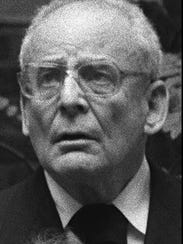“Off with you! You're a happy fellow, for you'll give happiness and joy to many other people.
There is nothing better or greater than that!”
AUTHOR: Ludwig van Beethoven

MEANING OF THE QUOTE:
“The greatest happiness one can give himself
is the joy of making other people happy.”

MEANING OF THE QUOTE:
“The greatest happiness one can give himself
is the joy of making other people happy.”
COMPOSER
COPLAND


 |
Billy the Kid Suite
Conductor: Philip Ellis
The Royal Philharmonic Orchestra



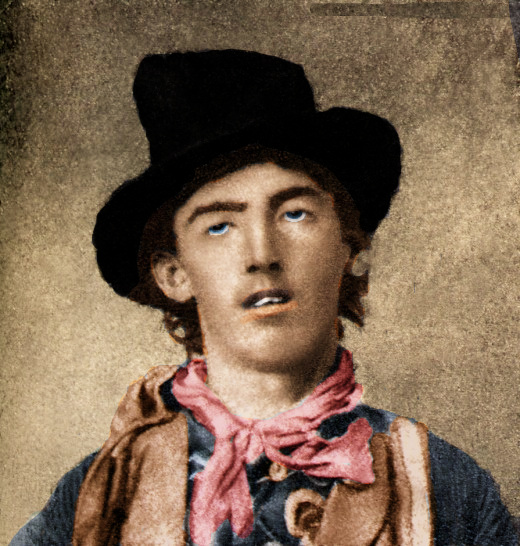
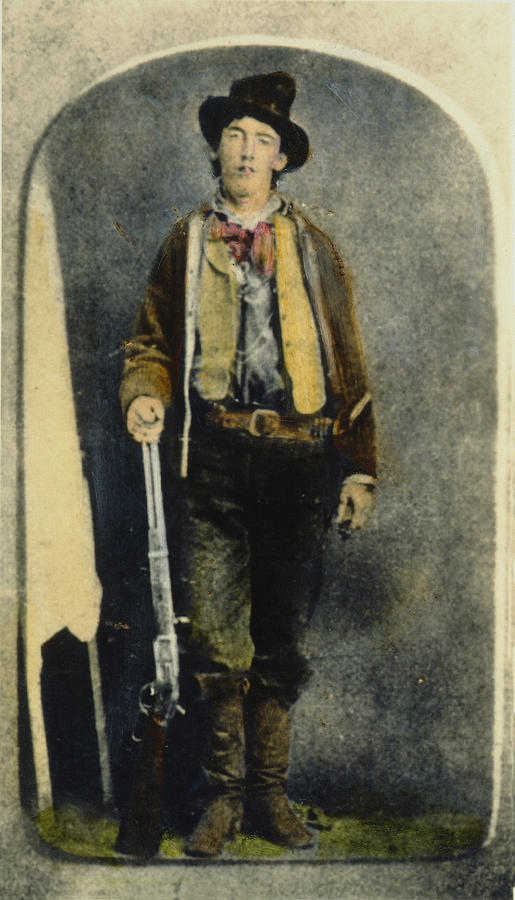
The score is prefaced by Copland's
synopsis of the ballet's plot:
"The action begins and closes on the open prairie. The central portion
of the ballet concerns itself with the significant moments in the life of
Billy the Kid. The first scene is a street in a frontier town. Familiar
figures amble by. Cowboys saunter into town, some on horseback,
others with their lassos. Some Mexican women do a Jarabe which is
interrupted by a fight between two drunks. Attracted by the gathering
crowd, Billy is seen for the first time as a boy of twelve with his mother.
The brawl turns ugly, guns are drawn, and in some unaccountable way,
Billy's mother is killed. Without an instant's hesitation, in cold fury,
Billy draws a knife from his cowhand's sheath and stabs his mother's
slayers. His famous career has begun. In swift succession we see
episodes from Billy's later life. At night, under the stars, in a quiet card
game with his outlaw friends. Hunted by a posse led by his former friend
Pat Garrett. Billy is pursued. A running gun battle ensues. Billy is
captured. A drunken celebration takes place. Billy in prison is, of course,
followed by one of Billy's legendary escapes. Tired and worn in the
desert, Billy rests with his girl. Startled from a deep sleep, he senses
movement in the shadows. The posse has finally caught up with him.
It is the end."


Billy the Kid is a 1938 ballet written by the American
composer Aaron Copland and commissioned by Lincoln
Kirstein, director of the newly formed American Ballet
Caravan, a touring company that was a forerunner of the
New York City Ballet.
Playing a sort-of American Sergi Diaghilev (founder and
director of the famous Russian Ballets Russes), Kirstein
fixed on Copland as his Stravinsky (Diaghilev's most notable
composer-collaborator), intent on establishing an American
style of ballet distinct from Franco-Russian traditions.
For inspiration, because Copland admitted a marked antipathy
to such music at the time, Kirstein supplied Copland with two
books of cowboy songs, suggesting, but not insisting, that he
might incorporate some of them into his score, much as he had
done with south-of-the-border tunes in his recent orchestral
work El Salon Mexico.
Copland wrote not long afterward,
"in order to humor Mr. Kirstein, who said he didn't really care whether
I used cowboy material or not, I decided to take his two little collections
with me when I left for Paris in the summer of 1938.…Perhaps there is
something different about a cowboy song in Paris. But whatever the
reason may have been, it wasn’t very long before I found myself
hopelessly involved in expanding, contracting, rearranging and
superimposing cowboy tunes on the rue de Rennes in Paris."
I used cowboy material or not, I decided to take his two little collections
with me when I left for Paris in the summer of 1938.…Perhaps there is
something different about a cowboy song in Paris. But whatever the
reason may have been, it wasn’t very long before I found myself
hopelessly involved in expanding, contracting, rearranging and
superimposing cowboy tunes on the rue de Rennes in Paris."
Copland has incorporated into the score material from such tunes
as "Great Granddad," "Git Along, Little Dogies," "The Old Chisholm
Trail," and "Good-Bye, Old Paint." These are sometimes quoted intact
or relatively so, adding what he called
"fresh and unconventional harmonies…without spoiling their naturalness"
and sometimes he merely suggested, and frequently transformed the
melodies as if they were original themes.
Copland balked at employing perhaps the most famous cowboy tune,
"Home on the Range," remarking to his Parisian neighbor,
"I decided to draw the line someplace."
Billy the kid was designed as a one-act ballet
based on a semi-fictional treatment of the
notorious outlaw by Walter Noble Burns'
1926 book, "The Saga of Billy the Kid."

based on a semi-fictional treatment of the
notorious outlaw by Walter Noble Burns'
1926 book, "The Saga of Billy the Kid."

It was choreographed
by Eugene Loring.
by Eugene Loring.
 |
| Eugene Loring |
Copland completed the ballet at his home in
Peterborough, New Hampshire and it
premiered in Chicago on October 16, 1938
Peterborough, New Hampshire and it
premiered in Chicago on October 16, 1938
 |
| "Billy the Kid" Premiere: Ballet Caravan 1938 |
with Loring dancing the title role and with pianists
Arthur Gold and Walter Hendel performing a
two-piano reduction of the score.
Billy the Kid
For 2 Pianos
Performed by
Albert Tiu and Thomas Hecht
https://www.youtube.com/watch?v=euSSZfVCT5Y
The full orchestral version debuted in New York on
May 24, 1939 conducted by Fritz Kitzinger. Not long
after, on November 9, 1940, the seven-movement
orchestral suite, which retained approximately two-thirds
of the ballet score, was given its first performance by the
NBC Symphony Orchestra under conductor
William Steinberg.

Billy the Kid
Arthur Gold and Walter Hendel performing a
two-piano reduction of the score.
Billy the Kid
For 2 Pianos
Performed by
Albert Tiu and Thomas Hecht
https://www.youtube.com/watch?v=euSSZfVCT5Y
The full orchestral version debuted in New York on
May 24, 1939 conducted by Fritz Kitzinger. Not long
after, on November 9, 1940, the seven-movement
orchestral suite, which retained approximately two-thirds
of the ballet score, was given its first performance by the
NBC Symphony Orchestra under conductor
William Steinberg.

Billy the Kid
Paul Rissmann introduces Aaron Copland's
exciting music for the ballet, Billy the Kid."
Music Director, Adam Stern, discusses Aaron
Copland's score for the ballet "Billy the Kid."
The familiar orchestral Suite extracts some
two-thirds of the original ballet score.
The sections of Copland's Suite are:
The sections of Copland's Suite are:
I: Introduction: The Open Prairie
Billy the Kid
Orchestral Suite (2/3)
Erich Kunzel, Conductor
Cincinnati Pops Orchestra
Orchestral Suite (2/3)
Erich Kunzel, Conductor
Cincinnati Pops Orchestra
Billy the Kid
Orchestral Suite (3/3)
Erich Kunzel, Conductor
Cincinnati Pops Orchestra
https://www.youtube.com/watch?v=jWd7BH1rQW8

The complete ballet proceeds from one
musical section to the next without pause.
Billy the Kid
Complete Ballet Music (1938)
Part 1
Conductor: Antal Dorati
London Symphony Orchestra (1961)
https://www.youtube.com/watch?v=nrD36k8Sn2k
Introduction:
--------The Open Prairie--------
00:00
The story begins with Sheriff Pat Garrett
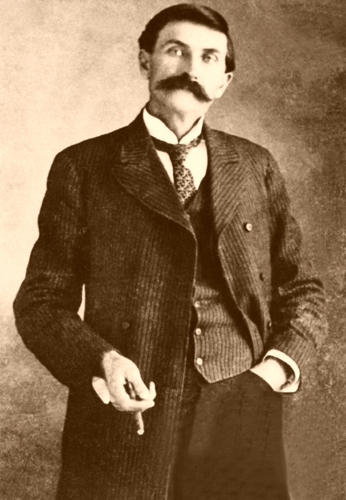
Billy the Kid
Orchestral Suite (3/3)
Erich Kunzel, Conductor
Cincinnati Pops Orchestra
https://www.youtube.com/watch?v=jWd7BH1rQW8

The complete ballet proceeds from one
musical section to the next without pause.
Billy the Kid
Complete Ballet Music (1938)
Part 1
Conductor: Antal Dorati
London Symphony Orchestra (1961)
https://www.youtube.com/watch?v=nrD36k8Sn2k
Introduction:
--------The Open Prairie--------
00:00
The story begins with Sheriff Pat Garrett

The complete ballet proceeds from one
musical section to the next without pause.
Billy the Kid
Complete Ballet Music (1938)
Part 1
Conductor: Antal Dorati
London Symphony Orchestra (1961)
https://www.youtube.com/watch?v=nrD36k8Sn2k
Introduction:
--------The Open Prairie--------
00:00
The story begins with Sheriff Pat Garrett
 |

leading pioneers westward across the open prairie.
The music opens with a song called "The Open Prairie" that depicts the
westward movement of the pioneers (Copland's use of a 3/4 meter and
a trudging, syncopated bass line signifies the arduous journey across the
prairie musically illustrated with a spare, solemn arrangement for crescendo
winds and brasses playing wide-spaced harmonies. One might also envision
a sunrise (this also is a metaphor for the beginning; an introduction) over the
great plains.
The music begins quietly, with two high-register clarinets introducing a
theme harmonized in open fifths (giving the music a sense of emptiness and
loneliness), but the dynamic level steadily escalates to a triple-forte climax
with declamatory brass chords evoking the awesome power of the landscape.
Gradually the stage fills with people on the
Gradually the stage fills with people on the
way west, with Pat Garrett leading the way.
--------Street in a Frontier Town--------
03:37
--------Street in a Frontier Town--------
03:37
The story shifts to a small frontier town

 |
| Billy the Kid's boyhood home in Silver City, looking northeast from the corner of Main and Broadway, circa 1880-83. |
The music abruptly shifts to a street scene
in a generic Western frontier town where
we first encounter Billy as a boy of twelve.
Lots of action on the street (horses, cowboys
sauntering around, etc.) is felt as bouncy strings,
winds, and brasses quote bits of Copland's adaptations
(unexpected harmonic colorings and clashes of key) of
the great cowboy songs Great Grandad, Old Chisholm Trail,
and Streets of Laredo while metrical asymmetries and cross
-rhythms build excitement until the scene erupts in chaos.
Great Grandad, the opening theme, is
played on the piccolo (replacing a tin whistle
in a generic Western frontier town where
we first encounter Billy as a boy of twelve.
Lots of action on the street (horses, cowboys
sauntering around, etc.) is felt as bouncy strings,
winds, and brasses quote bits of Copland's adaptations
(unexpected harmonic colorings and clashes of key) of
the great cowboy songs Great Grandad, Old Chisholm Trail,
and Streets of Laredo while metrical asymmetries and cross
-rhythms build excitement until the scene erupts in chaos.
Great Grandad, the opening theme, is
played on the piccolo (replacing a tin whistle
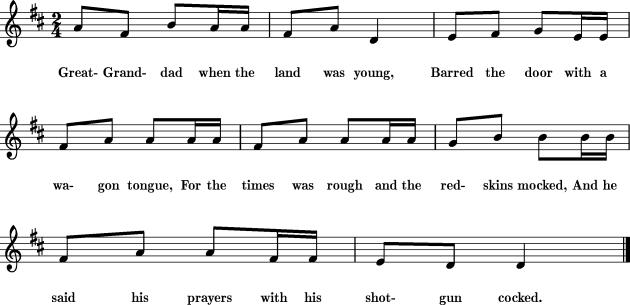 |
Great-Granddad
Sung by Adirondack Folk Singers:
Jamie Savage and Sue Grimm
https://www.youtube.com/watch?v=iQ2SNjCoWGw
Dissonant fragments of Git Along, Little Dogies intrude (with
the tune to come back later) as Copland paints a picture of "familiar
figures ambling by" on the main street of a frontier town. The
music quiets briefly until a fortissimo outbursdt from the full orchestra
leads to a spirited variant of the song The Old Chisholm Trail.
The Old Chisholm Trail
Dissonant fragments of Git Along, Little Dogies intrude (with
the tune to come back later) as Copland paints a picture of "familiar
figures ambling by" on the main street of a frontier town. The
music quiets briefly until a fortissimo outbursdt from the full orchestra
leads to a spirited variant of the song The Old Chisholm Trail.
The Old Chisholm Trail
![[music and
notation.]](http://www.kancoll.org/khq/images/39_1_hull01.jpg) |
| http://www.kancoll.org/khq/1939/39_1_hull.htm |
Sung by Woody Guthrie
| http://www.joe-offer.com/folkinfo/songs/642.html |
Sung by Hank Williams Jr.
--------Mexican Dance and Finale--------
Toward the end of this section Billy's mother is killed
by a stray bullet during a gunfight. Billy then kills the
man responsible for his mother's death and goes on the
run, living the life of an outlaw.
A Mexican theme enters which indicates a Mexican
woman dancing a Jarabe. Copland achieved this
Mexican feel with the clever use of irregular rhythms
using the song"Come Wrangle yer Bronco" with a
time signature of 5/8 and occasional bars of 4/8.
Come wrangle your branco and saddle him quick!
The cook is in trouble down there by the creek!
Oh, cinch up your latigoes, all of you runts,
And pull 'em so tight that your 'ol bronco grunts,
We'll need all the punchers the foreman can send,
'Cuz the chuck wagons mired down there by the bend.
The cattle are scattering all over the plain,
While the punchers are yelling in language profane!
But let 'em spread out-for the cooks in a muss,
And quicksand's are causing the fellow to cuss.
Oh, this is the time every puncher's his friend,
'Cuz the chuck wagons mired down there by the bend!
Come with your ropes that are heavy and stout!
No grub for the bunch till the wagon's pulled out!
It's in to the hubs and sinking down slow,
And cookie is a cussin' and watching it go!
Come, hustle, you punchers and haul him to land,
Before we are conquered by water and sand!
A-straining of ropes and a-grunting of nags,
And woe to the puncher whose lariat sags!
It's spur them and quirt them and make them lay to-
And now she is moving! And now she is through!
It's worth all the time and effort required,
"Cuz it's nothing to east when the chuck wagon is mired!
Two trombones impersonate drunken
cowboys to the tune, Git Along Little Dogies.
Git Along, Little Dogies
The cook is in trouble down there by the creek!
Oh, cinch up your latigoes, all of you runts,
And pull 'em so tight that your 'ol bronco grunts,
We'll need all the punchers the foreman can send,
'Cuz the chuck wagons mired down there by the bend.
The cattle are scattering all over the plain,
While the punchers are yelling in language profane!
But let 'em spread out-for the cooks in a muss,
And quicksand's are causing the fellow to cuss.
Oh, this is the time every puncher's his friend,
'Cuz the chuck wagons mired down there by the bend!
Come with your ropes that are heavy and stout!
No grub for the bunch till the wagon's pulled out!
It's in to the hubs and sinking down slow,
And cookie is a cussin' and watching it go!
Come, hustle, you punchers and haul him to land,
Before we are conquered by water and sand!
A-straining of ropes and a-grunting of nags,
And woe to the puncher whose lariat sags!
It's spur them and quirt them and make them lay to-
And now she is moving! And now she is through!
It's worth all the time and effort required,
"Cuz it's nothing to east when the chuck wagon is mired!
Two trombones impersonate drunken
cowboys to the tune, Git Along Little Dogies.
Git Along, Little Dogies
![[music and notation.]](http://www.kancoll.org/khq/images/39_1_hull02.jpg) |
Sung by Roy Rogers
As a street fight ensues the melodic material piles up as
more and more people gather at the site to watch. The
music grows louder and more raucous as the fight
escalates (full orchestra) until one person accidentally
shoots Billy's mother. Enraged, Billy grabs a knife and
stabs the shooter to death. By using the song Goodbye
Old Paint for the closing of this scene Copland mighthave been suggesting that Billy was saying good-bye to
his old life as he now has become a wanted criminal.
Sung by Tex Ritter
 |
| http://abook.org/cowboy-songs/ |

Billy the Kid
Complete Ballet Music (1938)
Part 2
Conductor: Antal Dorati
London Symphony Orchestra (1961)
The scene shifts to several years in the future. Billy
is an outlaw living in the desert, playing cards with
his companions at night. The trumpet
portrays the Kid as a lonely character.

is an outlaw living in the desert, playing cards with
his companions at night. The trumpet
portrays the Kid as a lonely character.

 |
| Possibly Billy the Kid (William Bonney) near the age of 18 |
In a brief calm 12/8 nocturne interlude, a solo trumpet intones
the main theme loosely adapted from Oh Bury Me Not on the
Lone Prairie (also known as The Dying Cowboy). A lonely,
reflective move "under the stars" is established. Billy does not
know that he has been racked down by the posse after him.
Bury Me Not on the Lone Prairie
the main theme loosely adapted from Oh Bury Me Not on the
Lone Prairie (also known as The Dying Cowboy). A lonely,
reflective move "under the stars" is established. Billy does not
know that he has been racked down by the posse after him.
Bury Me Not on the Lone Prairie
--------Gun Battle--------
During a gunfight with a posse,
Billy is captured and taken to jail.
Billy is captured and taken to jail.
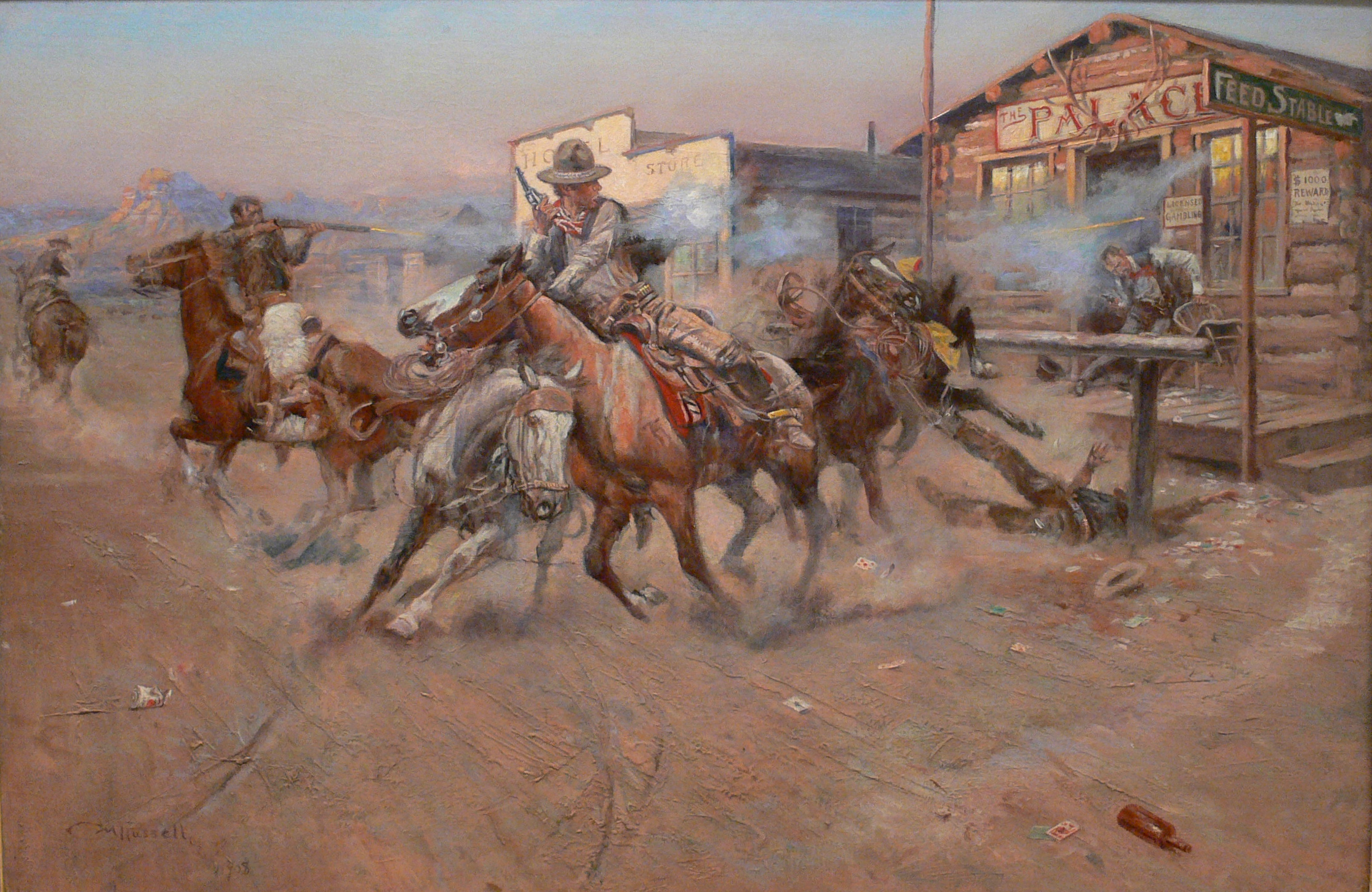 |
| Charles M. Russell: Smoke of a .45, 1908, Amon Carter Museum, Fort Worth |
A violent shootout ensues and Billy's gang is defeated.
The battle is vividly depicted by bleating brasses (rapid
-fire muted trumpets), stark, angular snippets of melody
in the strings, and the heavy use of all types of percussion:
xylophone, pounding timpani, and the rat-a-tat of the snare
drum. Billy is represented by the higher pitched snare drum;
the sheriff and posse are represented by the kettle drums.

The battle is vividly depicted by bleating brasses (rapid
-fire muted trumpets), stark, angular snippets of melody
in the strings, and the heavy use of all types of percussion:
xylophone, pounding timpani, and the rat-a-tat of the snare
drum. Billy is represented by the higher pitched snare drum;
the sheriff and posse are represented by the kettle drums.

Allegedly this is the rock house where Pat Garrett and his posse
actually captured Billy the Kid and his gang called the Rustlers.
actually captured Billy the Kid and his gang called the Rustlers.
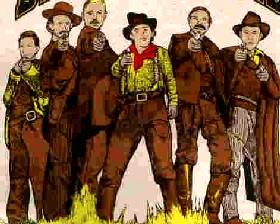 |
--------Celebration--------
(after Billy's Capture)
People celebrate the capture of Billy the Kid.
While everyone is celebrating the Kid escapes
from jail by killing two guards.
When the gunfire subsides justice has prevailed. Billy is captured
undoubtedly bringing in a renewed sense of safety among the
townspeople who wildly celebrate Billy's capture with a jaunty but
crude dance (in the ballet the choreographer Loring originally
envisioned it as "a macabre polka" with the dancers hopping nimbly
among the bodies of the dead outlaws). The music suggests an out-
of-tune saloon piano with a long ostinato in C-sharp supporting the
vulgar C-Major tune creating a sharp dissonance.

Then Billy escapes from jail into the
desert where he romances his sweetheart.
While everyone is celebrating the Kid escapes
from jail by killing two guards.
When the gunfire subsides justice has prevailed. Billy is captured
undoubtedly bringing in a renewed sense of safety among the
townspeople who wildly celebrate Billy's capture with a jaunty but
crude dance (in the ballet the choreographer Loring originally
envisioned it as "a macabre polka" with the dancers hopping nimbly
among the bodies of the dead outlaws). The music suggests an out-
of-tune saloon piano with a long ostinato in C-sharp supporting the
vulgar C-Major tune creating a sharp dissonance.

Then Billy escapes from jail into the
desert where he romances his sweetheart.
| Actual account of Billy the Kid's escape. |
| The Courthouse in Lincoln (late 1880's-90's) from which Billy the Kid escaped. |

Billy the Kid
Complete Ballet Music (1938)
Part 3
Conductor: Antal Dorati
London Symphony Orchestra (1961)
--------Waltz from Billy the Kid--------
--------Billy's Death--------
Billy, alone on the prairie, is hunted
down by Pat Garrett and shot dead.
Billy escapes. As he stops to rest in the desert
with his girl, the posse catches up with him is
killed by Garrett with a single shot.
Billy’s death is represented by a quietly mournful passage
for the outlaw’s death; a gentle statement of rich descending
chords in the strings with occasional accompaniment by
upper winds that conveys nostalgia for the slain outlaw.

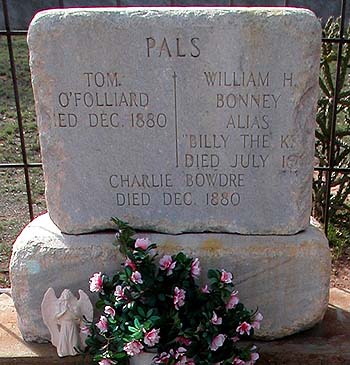
The opening theme returns with an image of
Sheriff Pat Garrett leading pioneers westward
across the open prairie.


https://www.youtube.com/watch?v=4fbVpss8ftE
(0:07) Introduction: The Open Prairie
(3:30) Street in a Frontier Town
(10:02) Card Game at Night
(13:08) Gun Battle
(15:06) Celebration Dance
(17:24) Epilogue: The Open Prairie Again
This is a re-orchestrated version of the opening prairie music, [bringing to
mind a beautiful sunset (as the piece is coming to an end)], but according
to Copland meant a way
"to convey the idea of a new dawn breaking."
To help with the feeling of finality, this time Copland uses the whole
orchestra with the brass playing big chords of leaping fifths (the wide-
spaced chords representing the wide-open prairie). This is all strong
motivation to lead to the conclusion that Copland wanted the audiences
loyalties to lie with the now dead outlaw. The music then subsides into the
original "Open Prairie" setting ending the suite where it began.

--------------------------------------------------

 |
| Jacques Moitoret: A Painting of Billy the Kid |
Billy the Kid
Ballet Suite
Conductor: Eugene Ormandy
Philadelphia Orchestra (1955)
https://www.youtube.com/watch?v=4fbVpss8ftE
(0:07) Introduction: The Open Prairie
(3:30) Street in a Frontier Town
(10:02) Card Game at Night
(13:08) Gun Battle
(15:06) Celebration Dance
(17:24) Epilogue: The Open Prairie Again


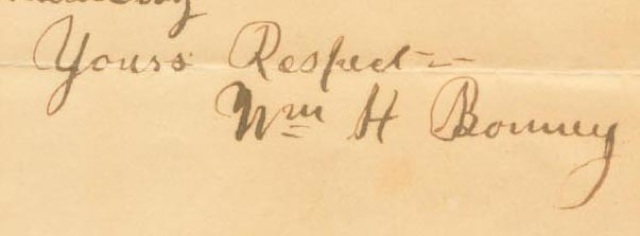
LINKS
http://www.wwnorton.com/college/music/listeninglab/shared/listening_guides/copland_billy_the_kid.pdf
 |
| Billy The Kid (1859-81) Shoots a Bartender in an Alleged Incident |
 |
| Michael Schreck https://americangallery.wordpress.com/2010/04/09/ |
LESSON PLANS
 |
| Andy Thomas: Billy the Kid and the Regulators |
"Billy"
Folk Song
Folk Song
Written by Bob Dylan

"Billy The Kid"
Folk Song
by Woody Guthrie and Jack Elliott

"Billy The Kid"
Folk Song
Sung by Vernon Dalhart
"Me and Billy the Kid
Never Got Along"
Joe Ely

